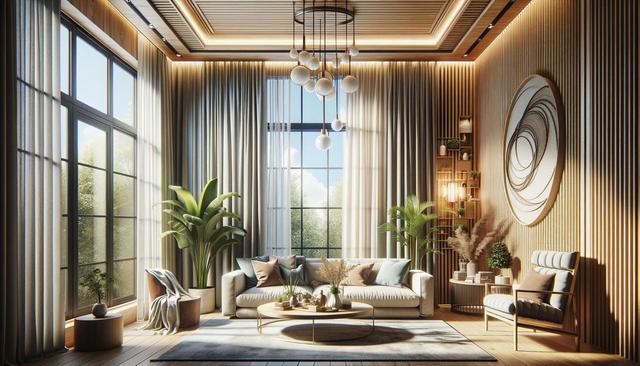The Shift Away from Vertical Blinds
For years, vertical blinds dominated the world of window coverings, particularly in homes and apartments seeking a practical solution for large windows and sliding doors. However, interior design trends have shifted significantly, making room for more sophisticated and visually appealing alternatives. Vertical blinds, while functional, often lack the warmth and character that today’s homeowners are looking for. Their utilitarian appearance can clash with modern aesthetics that lean toward cozy, layered, and textured environments. The current trend favors window coverings that double as decor elements, offering not just privacy and light control, but also a touch of personality and elegance.
This movement away from vertical blinds is partly driven by the increased interest in home customization. People want their living spaces to reflect their tastes, and window treatments have become a significant part of that expression. As a result, minimalistic and industrial looks are giving way to softer, more natural materials and designs that blend seamlessly with interior decor. Homeowners are now exploring a wider variety of materials, colors, and styles that vertical blinds simply can’t offer.
The Rise of Fabric-Based Window Coverings
One of the most notable trends in window coverings today is the popularity of fabric-based options. These include Roman shades, cellular shades, and drapery panels, all of which offer a more refined and elegant look than vertical blinds. Fabric coverings add texture to a space and can be customized to fit any room’s theme, from minimalist to bohemian. Additionally, they provide excellent light filtering options and can even help regulate indoor temperatures, making them both beautiful and functional.
Some advantages of fabric window coverings include:
- Enhanced visual appeal and customization
- Improved insulation for energy efficiency
- Variety of light filtering and blackout options
- Softening effect on room acoustics
These qualities make them a preferred choice for bedrooms, living rooms, and even home offices. With so many textures, patterns, and colors available, fabric window coverings offer versatility that vertical blinds simply cannot match.
Natural Materials and Organic Textures
Another trend gaining momentum is the use of natural materials in window treatments. Bamboo shades, wooden blinds, and linen drapery are now widely embraced for their aesthetic value and eco-friendly appeal. These materials bring an earthy, grounded feel to interiors, creating a serene and welcoming atmosphere. Their neutral tones and organic textures work well with a variety of color palettes and design styles, from coastal casual to Scandinavian minimalism.
Natural window coverings are particularly popular in spaces that aim to bring the outdoors in. They pair beautifully with houseplants, raw wood furniture, and light, airy color schemes. Beyond their appearance, these materials are also durable and sustainable, making them a responsible choice for eco-conscious homeowners. Whether used as standalone pieces or layered with sheer curtains, natural materials are helping redefine what stylish window coverings look like.
Layered Treatments for Depth and Functionality
Layering window treatments is another chic trend transforming how people think about window coverings. Instead of relying on a single type of blind or shade, designers are now combining elements—such as sheer curtains with blackout liners or bamboo shades with flowing drapes—to achieve depth, dimension, and better control over light and privacy. This layered look adds richness to a room and allows for greater flexibility in how the space is used throughout the day.
Key benefits of layering window treatments:
- Enhanced light control and insulation
- Increased privacy without sacrificing style
- Ability to coordinate with multiple design elements
- Customizable looks for each season or mood
Layered treatments can also be adapted to various window sizes and types, making them a versatile solution for any home. Whether aiming for a dramatic statement or a soft, understated finish, layers add a designer touch that elevates the entire room.
Smart and Motorized Options
Technology has made its way into window coverings, and smart, motorized options are becoming increasingly popular. These window treatments can be controlled via remote, smartphone, or even voice commands, offering convenience and efficiency. Perfect for hard-to-reach windows or for those looking to automate their home environment, motorized blinds and shades provide a modern solution that fits seamlessly into contemporary living.
Motorized window coverings are available in various styles, including roller shades, Roman shades, and even drapery systems. Many of these systems can be integrated with existing smart home ecosystems, allowing users to schedule opening and closing times, adjust settings based on sunlight, or control multiple rooms at once. This level of convenience, combined with sleek design options, has made motorized treatments an appealing upgrade for those renovating or modernizing their homes.
As this technology becomes more accessible and user-friendly, it’s likely to become a staple in new home builds and remodels. Not only do these options provide comfort and energy savings, but they also add a layer of sophistication to any room, helping homeowners stay ahead of design trends.
Conclusion: Embracing the New Wave of Window Coverings
As vertical blinds fade from the spotlight, a refreshing variety of modern window coverings is taking their place. From soft fabric shades and natural materials to layered designs and smart automation, today’s homeowners have more stylish and functional options than ever. These trends not only enhance a room’s visual appeal but also contribute to comfort, privacy, and energy efficiency. Whether you’re redecorating a single space or rethinking your entire home, embracing these updated window treatments can help you create a look that feels both current and uniquely yours.






